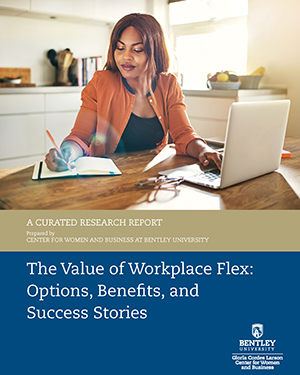Workplace Flex Research Report Request
 Thank you for your interest in the Gloria Cordes Larson Center for Women and Business (CWB) curated research report The Value of Workplace Flex: Options, Benefits, and Success Stories. Download the full report.
Thank you for your interest in the Gloria Cordes Larson Center for Women and Business (CWB) curated research report The Value of Workplace Flex: Options, Benefits, and Success Stories. Download the full report.
Executive Summary
A broad definition of workplace flexibility is the outcome of employers and employees working together to determine when, where and how much an employee works in order to meet mutual needs. It refers to practices that impact when, how, where, and how much people work. This report, based on a review of over 200 sources, explores the “state of the state” when it comes to the expansive array of flexible options that exist in the workplace today.
We begin with exploration of the major trends driving flexible work arrangements in organizations, including commitment to inclusion, gender, generational factors, global competition, and technology.
The report examines noteworthy statistics that demonstrate the overall value of flex, attitudes toward flex, and what’s being utilized most. Statistics consistently demonstrate that flexibility is a top consideration for employees in choosing jobs, and Gallup’s study asserts that workers are pushing companies to break down the long-established structures and policies that have historically influenced their workdays.
We identify and discuss the primary benefits for employers and employees, including: reduced costs resulting from greater efficiency and productivity; employee wellness and satisfaction; workplace recruitment and retention; sustainability factors such as reduction in real estate footprints; and stronger cultures.
The report delves into the primary categories of flexible work arrangements such as parental and family leave, remote work, flexible work, and unlimited vacation, while also citing a potpourri of other offerings ranging from sabbaticals and paid time off to hoteling and relaxed dress codes.
Readers will find numerous success stories that profile best practices. In addition, this part of the report provides good examples of how companies prioritize the benefits they derive from flexible options and the importance of communication.
In the section titled "When Flex Misses the Mark," we examine the negative impact of flexibility stigma when employees who use flex are viewed as less committed or less likely to receive raises and promotions. This section of the report also considers: the drawbacks of informal programs that are implemented inequitably or without transparency; the challenges for frontline managers who are so important to program success; why failure to utilize metrics is problematic; and the relevance of highly visible flex rollbacks by some major employers.
The report includes concrete recommendations for organizations and individuals and concludes with a glossary of terms related to flexible work arrangements.

